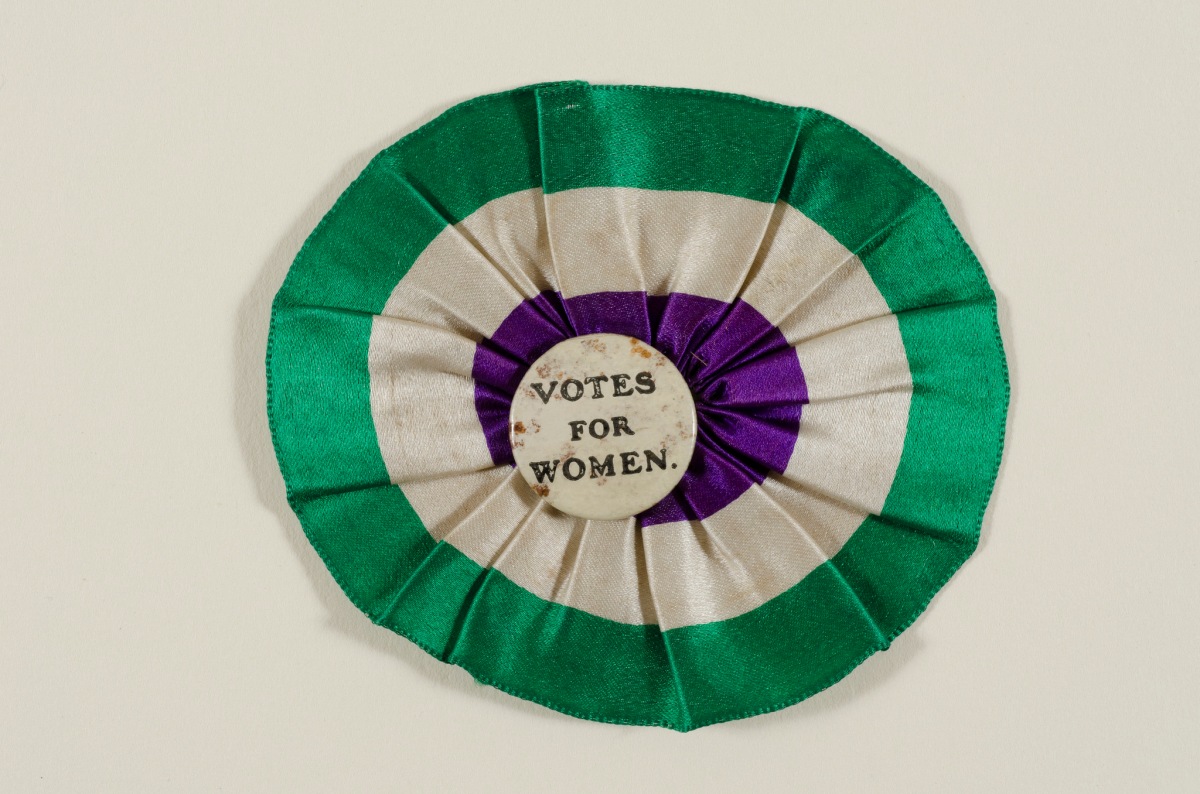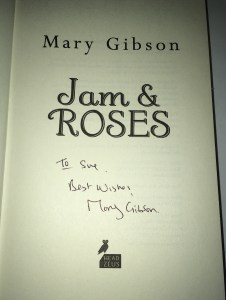Born on this day 1847 to a family of extraordinary women.
Author: Capital Walks in London
Sylvia Pankhurst – Everything is possible
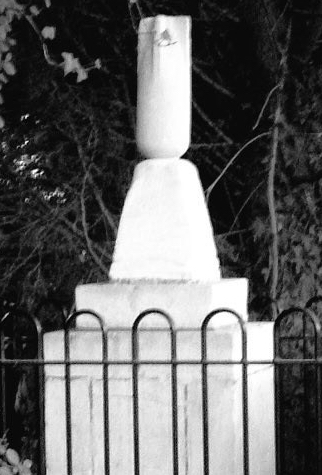
Excellent evening recently at WORLDwrite in #Hackney to see a screening of their Sylvia Pankhurst documentary. You can see a clip here: Source: Sylvia Pankhurst – Everything is possible
Votes for (some) women!
One hundred years ago today, on 6th February 1918, the Representation of the the People Act 1918 received Royal Assent and passed into law.
One hundred years ago today, on 6th February 1918, the Representation of the the People Act 1918 received Royal Assent and passed into law. The Act almost tripled the size of the electorate to seventy-eight percent of the adult population and gave around forty-three percent of adult women a vote.
“We should greatly prefer an imperfect scheme that can pass, to the most perfect scheme in the world that could not pass.” Millicent Garrett Fawcett

The political climate was not yet ready for women to have the vote on the same terms as men. It took another ten years for women and men to achieve equal franchise, but the 1918 Act did secure the vote for women over the age of 30 who met the property qualification. This change in the law was the result of decades of hard work, lobbying and campaigning by more than fifty suffrage societies.
While the militant “suffragettes” of Emmeline and Christabel Pankhurst’s Women’s Social and Political Union are the best known today, they were by no means the only campaigners: nor were all those who actively supported women’s suffrage female. Groups, now often overlooked, included Sylvia Pankhurst’s East London Federation of Suffragettes, the Men’s League for Women’s Suffrage, along with many others such as the Conservative and Unionist Women’s Franchise Association, the Church League for Women’s Suffrage, The Artists’ Suffrage League; and largest of them all, the National Union of Women’s Suffrage Societies led by Millicent Garrett Fawcett.
It wasn’t until 1928 that all women got the vote on the same terms as men, but before we wait another ten years for that centenary….
….. why not celebrate 100 years of Votes for (some) Women by joining one of our walks?
Suffragette City on 3rd March or 29th April gives an excellent overview of the Suffragette protests immediately before the First World War.
The Garretts of Gower Street on 18th February or 19th May focusses on Millicent Garrett Fawcett of the National Union of Women’s Suffrage Societies and the other extraordinary women of the Garrett family.
Or come to Bow, in the afternoon on 11th February for the Radical Women of the East End to find out more about Sylvia Pankhurst’s East London Federation of Suffragettes.
While on 18th February, in the morning Newington’s Radicals takes us right back to the 1790s and Mary Wollstonecraft’s Vindication of the Rights of Woman.
Helping Hands
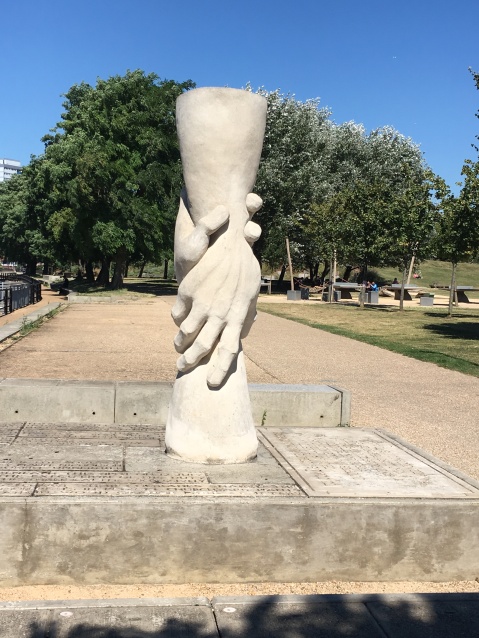
- Helping Hands by Alec Peever 2001
This sculpture of clasped hands on Three Mills Green by Alec Peever, commemorates four tragic deaths in an industrial accident one hundred and sixteen years ago today. On 12th July 1901 three workmen and the Managing Director of the nearby Nicholson’s Gin Distillery met a tragic end.
Today Three Mills is a picturesque spot, a time warp just minutes from the busy Bow Flyover, but it is also part of our earliest industrial heritage. There have been wind and tidal river mills on the site since medieval times, grinding flour, corn and even gunpowder. By the 1730s a distillery was established and gin (made popular by the Dutch king of England, William III) was produced here. From 1872, the business was owned and run by J&W Nicholson of Nicholson’s Gin fame.
-

Clock Mill at low tide
On 12th July 1901, Godfrey Maule Nicholson, Managing Director of the distillery, Albert Dawkins, the foreman and two other workers went to open up a sealed well on a corner of the site to see if it could be used again. The well had fallen out of use a couple of years previously when the London County Council built a sewer nearby and the water dried up. Recently, Mr Nicholson had learned that the sewer was no longer in use and he wanted to see if it would be possible to use the well again. It was a hot summer and the additional water supply would be useful.
A ladder was put down the well and 26 year old Thomas Pickett, one of the labourers, descended with an 11 foot measuring pole to test the water level. As Thomas climbed back up and passed the pole to his foreman, he suddenly collapsed and fell back into the well. Without thought, 29 year old Godfrey Nicholson quickly climbed over and was trying to pull Thomas clear of the water when he too was overcome and fell in. Before Albert Dawkins, the foreman could follow, the second labourer, Joseph Barbour, stopped him suggesting that the men may have been overcome by fumes.
As Dawkins and Barbour ran off to get a rope, and ignoring their entreaties not to go too far down the well un-roped, a third workman, 35 year old George Frederick Elliott descended to try to recover his colleagues but he too was overcome and fell into the water. Despite the, by now obvious, dangers from noxious fumes a fourth man, 24 year old Robert Arthur Underhill, climbed down in another attempt to rescue his fellows and he too slumped into the water.
Thankfully, a rope was found and although the next man down, Job Vanning was also quickly overcome by the gases, he could be pulled clear by his colleagues and escaped drowning. When he recovered he said there had been no apparent smell but he had felt suddenly sleepy. He had no recollection of being pulled out of the well.
The Fire Brigade retrieved the bodies of the four men who were certified dead at the scene by local doctor Francis J Hilliard. At the inquest held the following Saturday, the jury returned verdicts of accidental death for all four men and expressed regret that the precaution of lighting a candle to test for the presence of gas, had not been employed.
The Coroner, Mr Attwater praised the bravery of those who had gone down the well to try to rescue their colleagues and the courage of Mr Vanning.
Alec Peever’s sculpture, erected in 2001, one hundred years after the tragedy, replaced an earlier monument a short distance away at the exact site of the well. This is now marked by a simple plaque.

- Site of the well
Stone tablets from the original monument have been incorporated into the new memorial, including the following inscription:
“Of your charity pray for the souls of Thomas Pickett, Godfrey Maule Nicholson, Frederick Elliott and Robert Underhill, who lost their lives in a well beneath this spot on 12 July 1901. The first named while in the execution of his duty was overcome by foul air. The three latter successively descending in heroic efforts to save their comrades shared the same death.”
The valour of Elliott, Nicholson and Underhill is also commemorated in Victorian artist, GF Watts’ memorial to acts of heroic self sacrifice at Postman’s Park in the City of London.
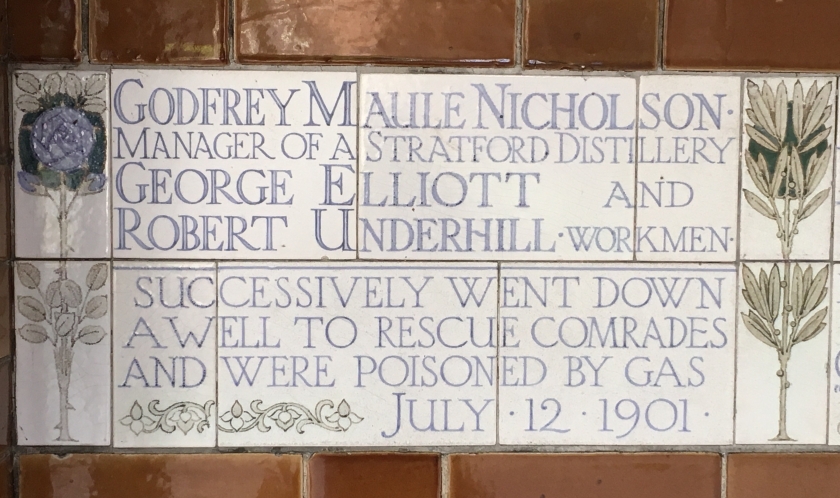
- Plaque in Postman’s Park
Godfrey Nicholson was buried in his home parish at Holy Trinity Church, Privett, Hampshire where he is commemorated by a stained glass window and a marble plaque.
The three workmen who died were all buried locally in Woodgrange Park Cemetery where they appear to have no lasting monument. Sadly, much of the privately-owned 29 acre cemetery is in a very dilapidated state.

- Overgrown and damaged graves at Woodgrange Park Cemetery
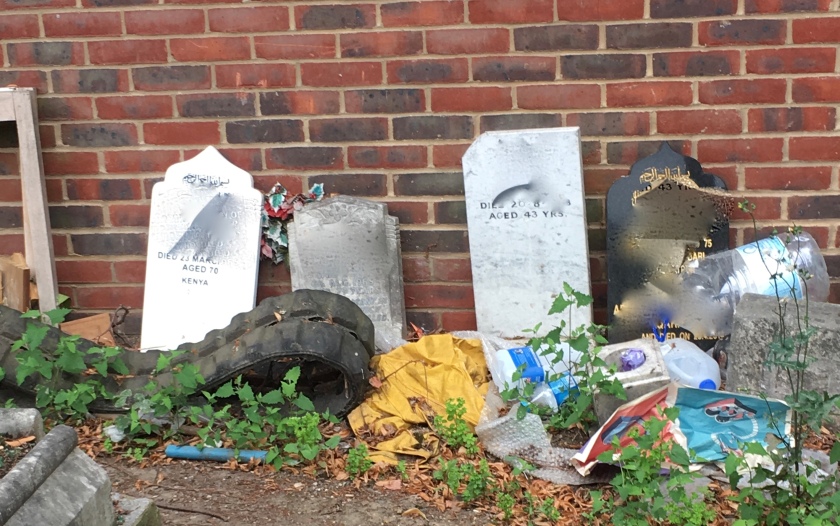
- Headstones at Woodgrange Park Cemetery
Graves are overgrown by brambles, headstones are broken and jumbled and many paths are no longer passable. Despite efforts by the Friends of Woodgrange Park Cemetery an Act of Parliament passed in 1993 allowed part of the site to be sold off for redevelopment as flats.
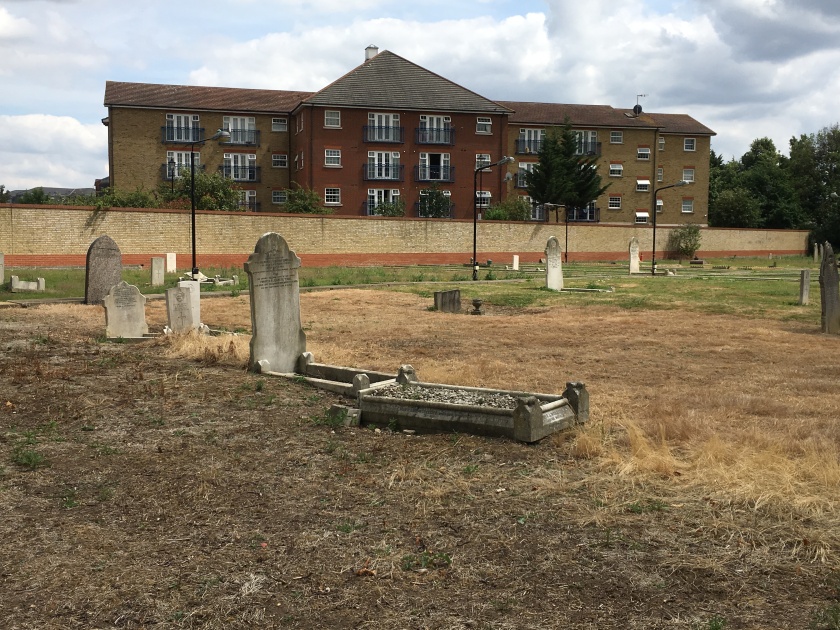
- New flats on land sold by Woodgrange Park Cemetery
The remains of those who had been buried in this area were removed and have been re-interred in the so-called Garden of Remembrance – a long strip of rough, yellowing grass marked with a single small memorial stone.
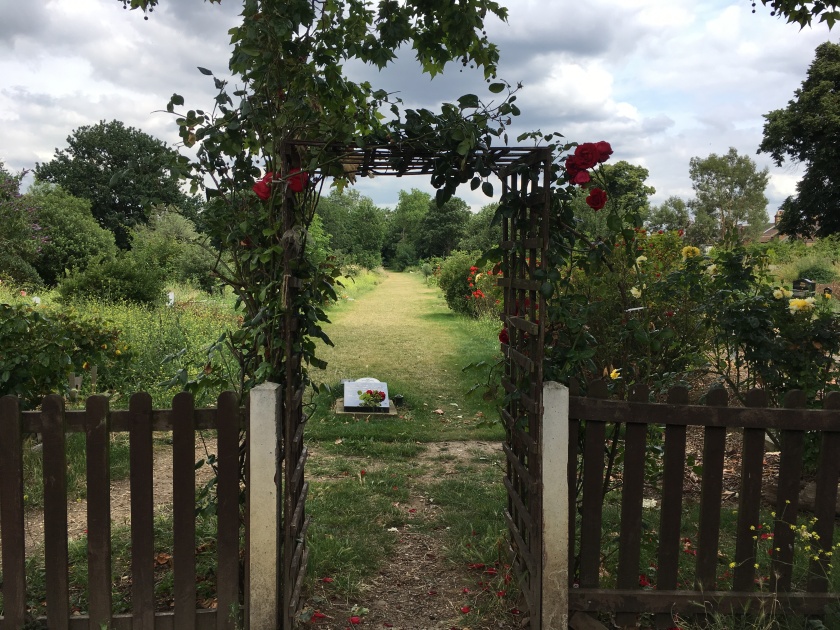
- The “Garden of Remembrance” Woodgrange Park Cemetery
Sadly, and perhaps especially after the care taken elsewhere to record the bravery of these four men, a visit to the cemetery where three of them were interred is a profoundly dispiriting experience.
Art and Industry in East London – guided walk 22nd July 2017
Recycling is not new…..
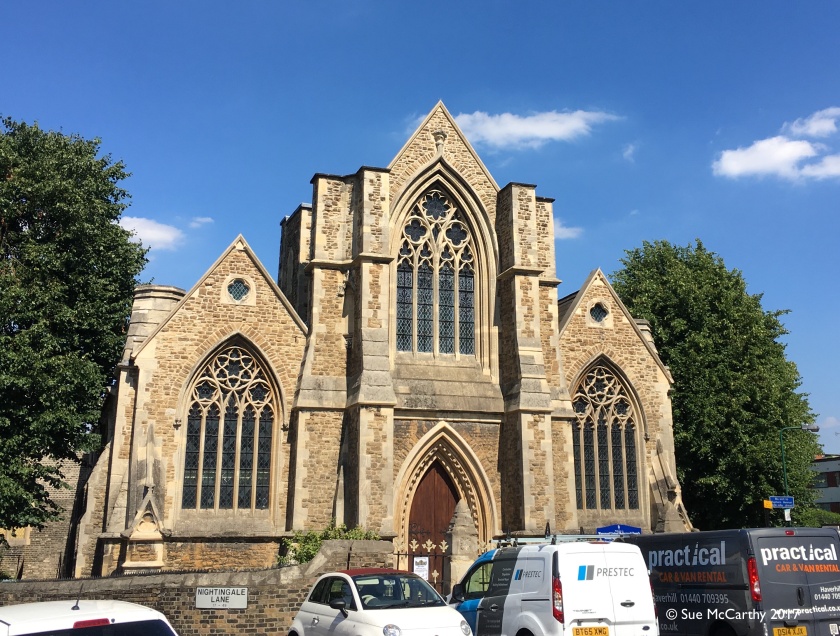
Looking at this imposing Grade II listed church in the east London suburb of Wanstead it would be hard to imagine its very unusual history.
Now well-connected by the Central Line and popular with young families, Wanstead in the 1860s was an Essex village with an expanding population and a growing community of religious non-conformists without a purpose-built place of worship. They had been offered land by a Mr GH Wilkinson, but rejected as too costly the plans drawn up for building on it.
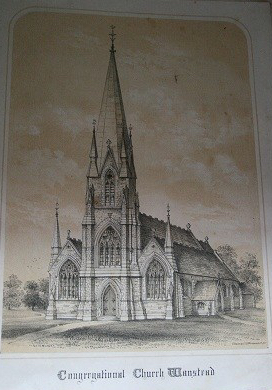
The non-conformists knew a bargain when they saw one, and the bargain they saw was nine miles away on the Euston Road where the junction with Midland Road is now. Here was a ready built church, only a few years old but already doomed by the onward march of the railway.
St Luke’s on the New Road (now Euston Road) was part of a Victorian church-building boom: 2,438 churches were built or re-built in England between 1851 and 1875 and St Luke’s was one of several planned to serve the needs of the ever-expanding population in the large urban parish of St Pancras.
Money had been short and work was slow. It took five years to complete the project and even then funds were insufficient for the tall spire on top of the tower.
The smart new building of Kentish ragstone with Bath stone dressings, designed by architect John Johnson, finally opened in 1861. However, the church was no competition for the might of the railway companies. A mere two years after the church was completed, the Midland Railway Company secured an Act of Parliament that would allow it to extend its line down to London, compulsorily purchase the land in its way (including that occupied by the church) and replace it with the cathedral-like splendour of St Pancras Station.
Pragmatically, the church quickly capitulated, accepted £12,500 for their early surrender of the land and were allowed to keep the fabric of the building.
At this point those astute non-conformists in Wanstead made an offer of £526 to buy the fabric of St Luke’s. This was accepted: Mr Reed a Walthamstow builder dismantled and transported the materials to Wanstead at a cost of £2,000. Even the crypt under the church was brought from the original site! John Johnson, the original architect, was commissioned to adapt his design to fit the rather different shaped and sized plot of land available.
As for St Luke’s, they had enough money from the deal to commission Basil Champneys to build a replacement safely out of the way of the railways in Oseney Crescent, Kentish Town.

References:
http://www.english-heritage.org.uk/learn/story-of-england/victorian/religion/
https://historicengland.org.uk/listing/the-list/list-entry/1393337
Art and Industry in East London – new improved version!

One of the joys, and sometimes frustrations, of walking in London is the speed of change as new buildings go up or hoardings come down and new views are exposed. The ‘same’ walk can change subtly or significantly over a few months. My Art and Industry in East London walk never disappoints. Even the start at Pudding Mill DLR station usually offers some change as work on Crossrail, or the Elizabeth Line as I suppose I should try to get into the habit of calling it, nears completion.
The former Lock Keeper’s Cottage at City Mill Lock, sold a couple of years ago, is now dwarfed by the new wraparound developments either side.

Although work has begun to re-open the off-road path that links to the Greenway it is not yet open, but cutting back to the road gives a great view of the old Yardley box factory.
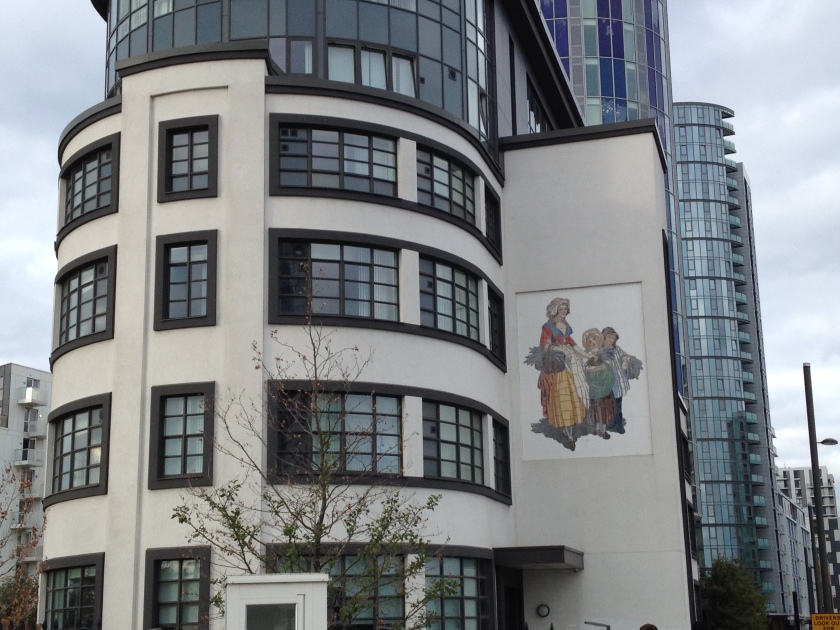
Pre-walking the route for the first time this summer there was one change to which I was looking forward very much! Thanks to the new ramp up from the River Lea up to Twelvetrees Crescent Bridge we can continue along the towpath all the way from Three Mills to Memorial Park with no need for the noisy road diversion along the Northern Approach to the Blackwall Tunnel!
Gas holders still dominate the skyline on the approach to Memorial Park, but planning notices herald huge changes with the proposed re-development by Berkeley Homes of the old Parcelforce site. Berkeley Homes have recently submitted a hybrid planning application including over 1,000 residential units, retail, business and leisure space, new bridges and a new secondary school.
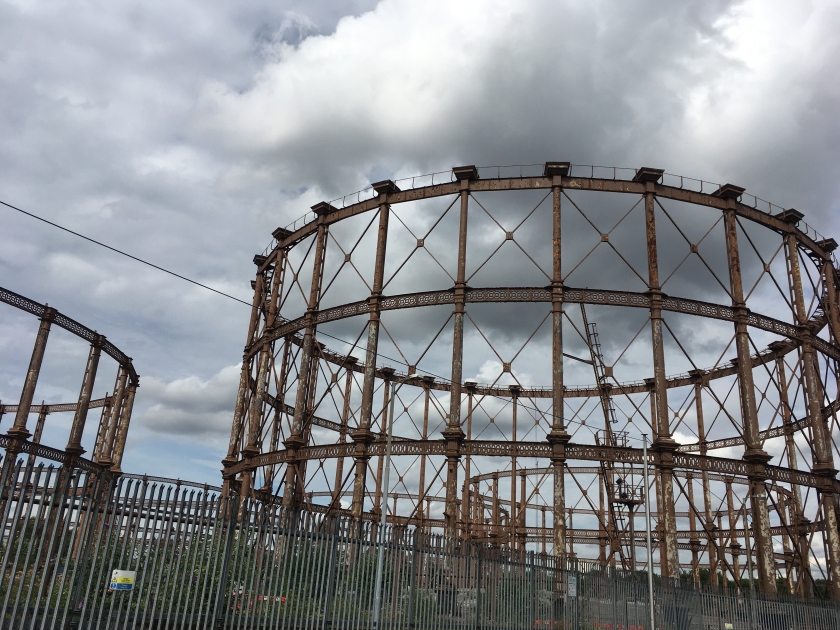
Heavy pollarding of nearby trees reveals the previously secluded former offices of the Gas, Light & Coke Company and gives a glimpse from the road of the company’s memorial to the employees who lost their lives in two world wars.
Back on the towpath, past Abigail Fallis’s shopping trolley sculpture, ironically close to the Sainsbury ‘online fulfilment centre’ there are no more changes until we arrive at the wonderful green oasis of Cody Dock where there is always something new!
If you want to explore this fascinating area why not join me on Saturday 22nd July? Advance booking through Eventbrite
Beautifying Bermondsey
-
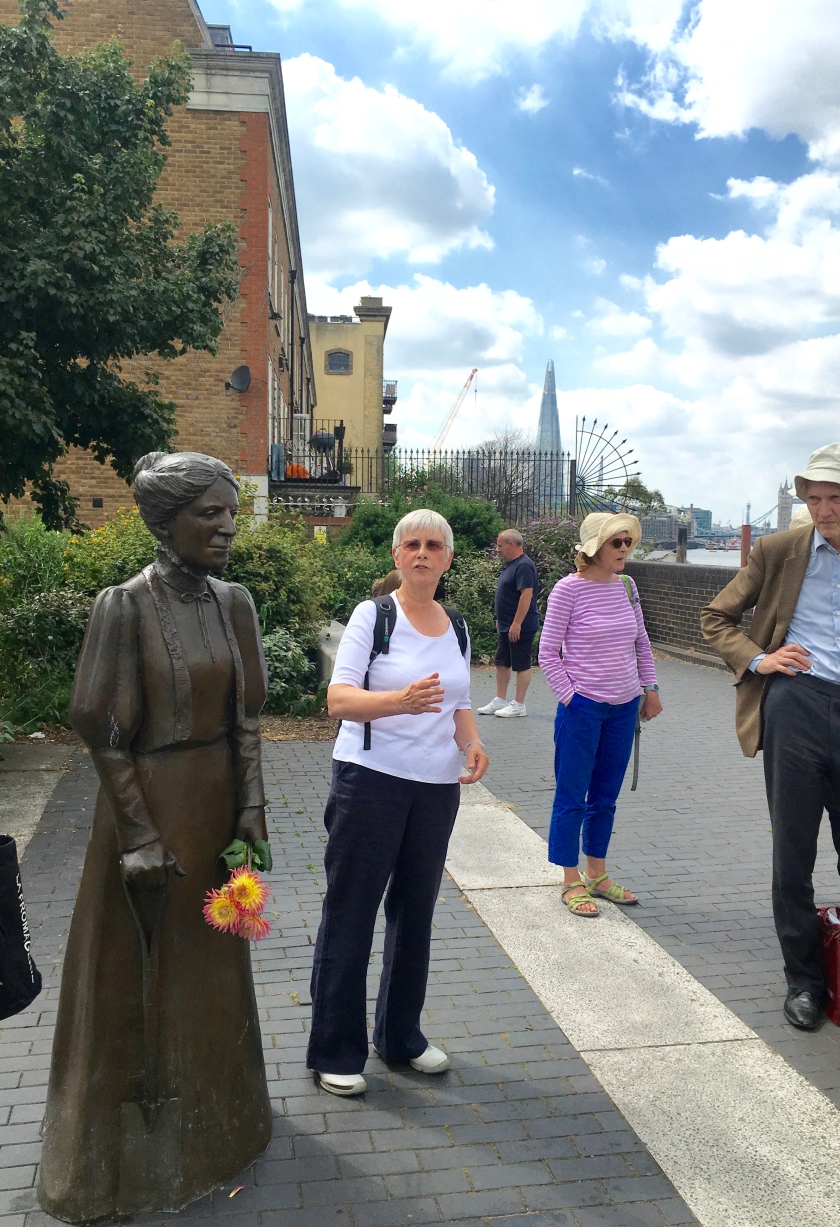
Ada Salter with her favourite flowers - Ada Salter with her favourite flowers © Oonagh Gay
Oonagh Gay of Crouch End Walks and I were joined by a very interesting group of walkers for our Ada Salter – Beautifying Bermondsey walk for Open Garden Squares on Saturday afternoon. Instead of our usual circular route that takes in all aspects of Ada’s fascinating life in Bermondsey, we concentrated on her horticultural achievements.
For the first time since we started the walks in the Spring we were able to use the grasp in Ada’s left hand, carefully crafted by sculptor Diane Gorvin, for some of her favourite dahlias. These long-stemmed imports, though are not as hardy as the seed-grown, single flowered Coltness variety favoured by Bermondsey Council nurseries in the 1920s that provided the Borough’s famously colourful displays in parks and window boxes. Bermondsey’s planting was rightly famous and Mr Johns, Superintendent of Gardens had three new strains of dahlia confirmed by the Royal Horticultural Society: Coltness Purple, Yellow and Salmon. The salmon-coloured was renamed Bermondsey Gem and the yellow, Rotherhithe Gem. Coltness mixed dahlia seeds are available from many suppliers – but I haven’t been able to track down any Bermondsey or Rotherhithe Gems.
Mr Johns’ favourite street tree was the flowering cherry and we saw cherries in abundance.
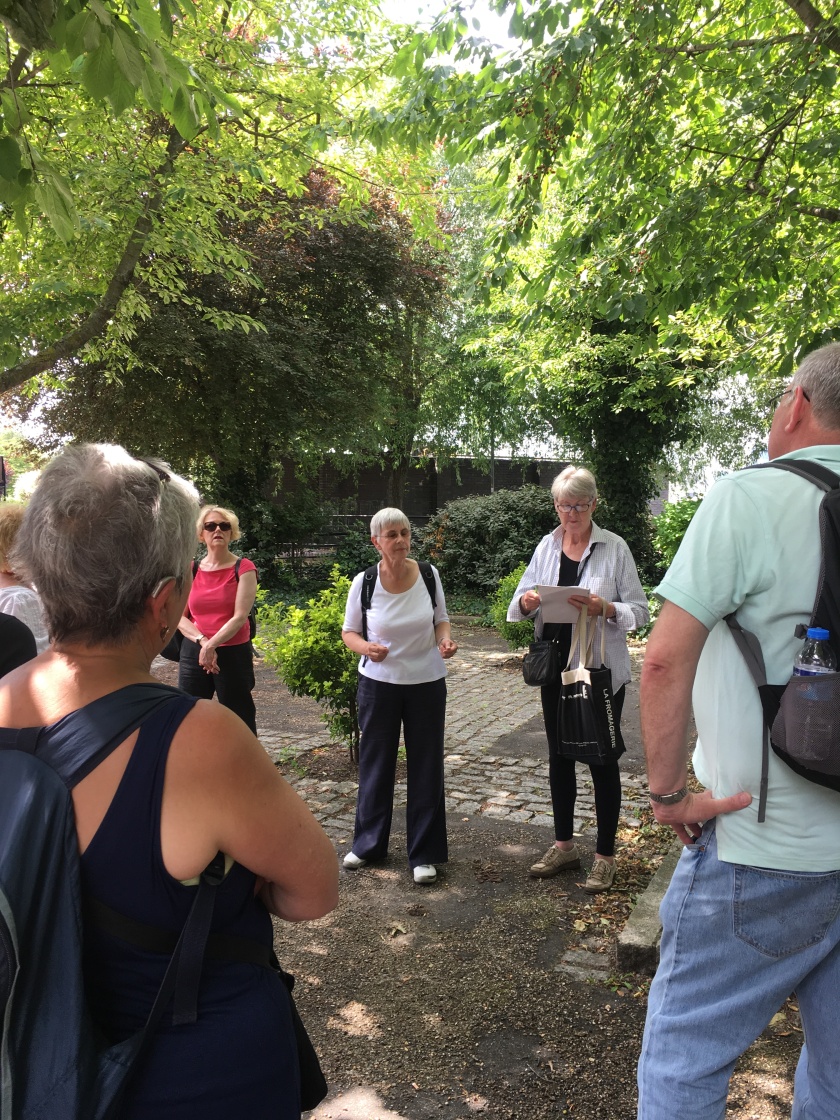
The Cherry Gardens of Samuel Pepys day are long gone, but the present Cherry Gardens, a small stretch of garden between River and housing on Bermondsey Wall marks a tussle between the local community and developers that Ada would surely have approved. Originally ear-marked by the local authority for low-density housing the land was compulsorily purchased in the 1980s by the London Dockland Development Corporation who threatened to obscure the River view and access with high rise blocks. Cherry Gardens today is part of the compromise reached when local people won out against the LDDC and Southwark Council regained half the land.

I don’t think the sculptor intended Ada and Alfred’s daughter Joyce to be embellished but when we visited on Saturday she was shaded from the sun by a distinctly contemporary baseball cap and fishing with the local lads. On a previous visit she was listening to music in a way unforeseen at the time of her tragically early death in 1910.
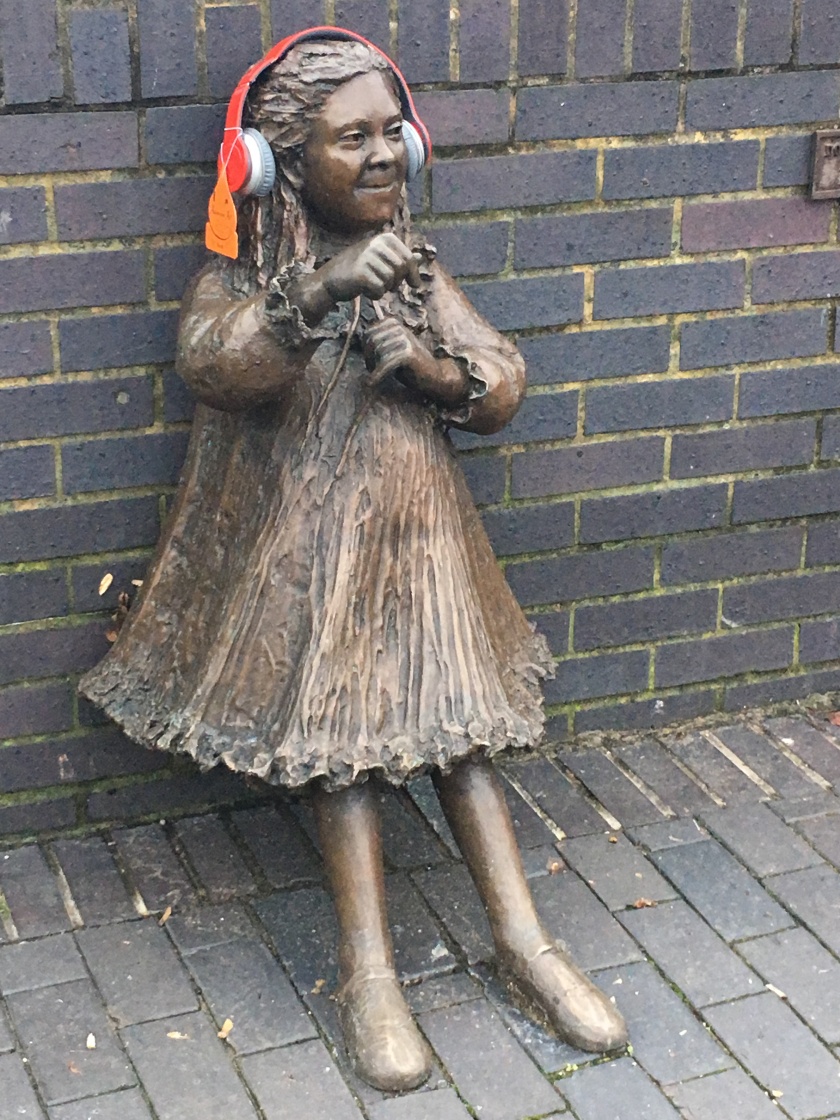
And further along the river wall at Providence Square, as Oonagh and I made our way back after visiting the wonderful floating gardens at Garden Barge Square, we met another young person fishing. This Banksy is much faded and it’s hard now to see the syringe on the end of his line.
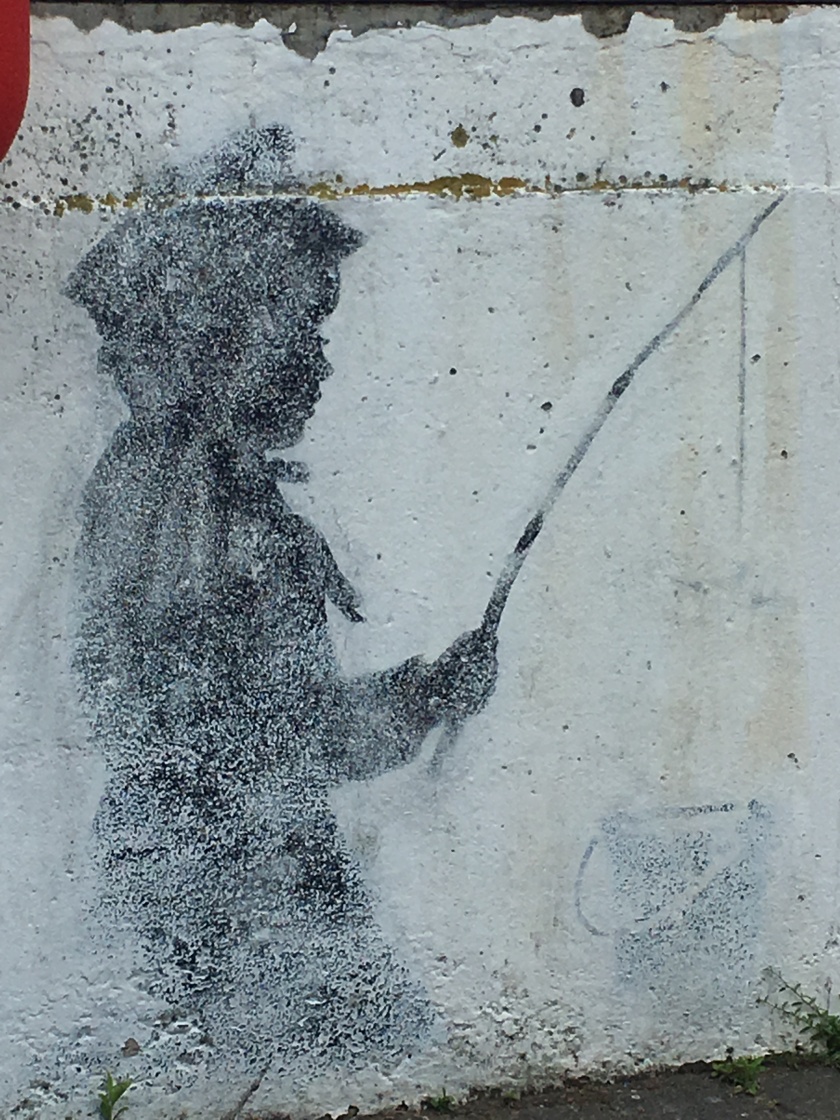
And if you would like the full version of this walk, Oonagh is leading the next one on 9th July. You can book here
Fresh Air and Fun
We got both fresh air and fun on yesterday’s Bermondsey walk and some stunning views of the Thames and the London skyline to boot! Each time I walk these streets as spring turns to summer and the trees come into full leaf, I marvel at how green Bermondsey is and how forward thinking Ada Salter was. After almost eighty years Bermondsey’s streets are still tree-lined and the estates full of well-maintained shrubs and playgrounds.
I was delighted and very touched when Bermondsey novelist, Mary Gibson gave me a copy of her second novel Jam & Roses, in which Ada features and which covers many of the places we covered on the walk. Mary has now published four novels set in Bermondsey and you can find out more about them on her website http://www.marygibsonauthor.co.uk
Beautifying Bermondsey
It was pretty windy when Oonagh led the first of our Ada Salter walks in Bermondsey last week, but that didn’t put off the group who all enjoyed the mix of Garden estate, old warehouses and sunning Thames views upriver. Ada’s trees, planted as part of the Beautification programme should look even better next Saturday with more in leaf. Why not join us and enjoy the Salters’ legacy?


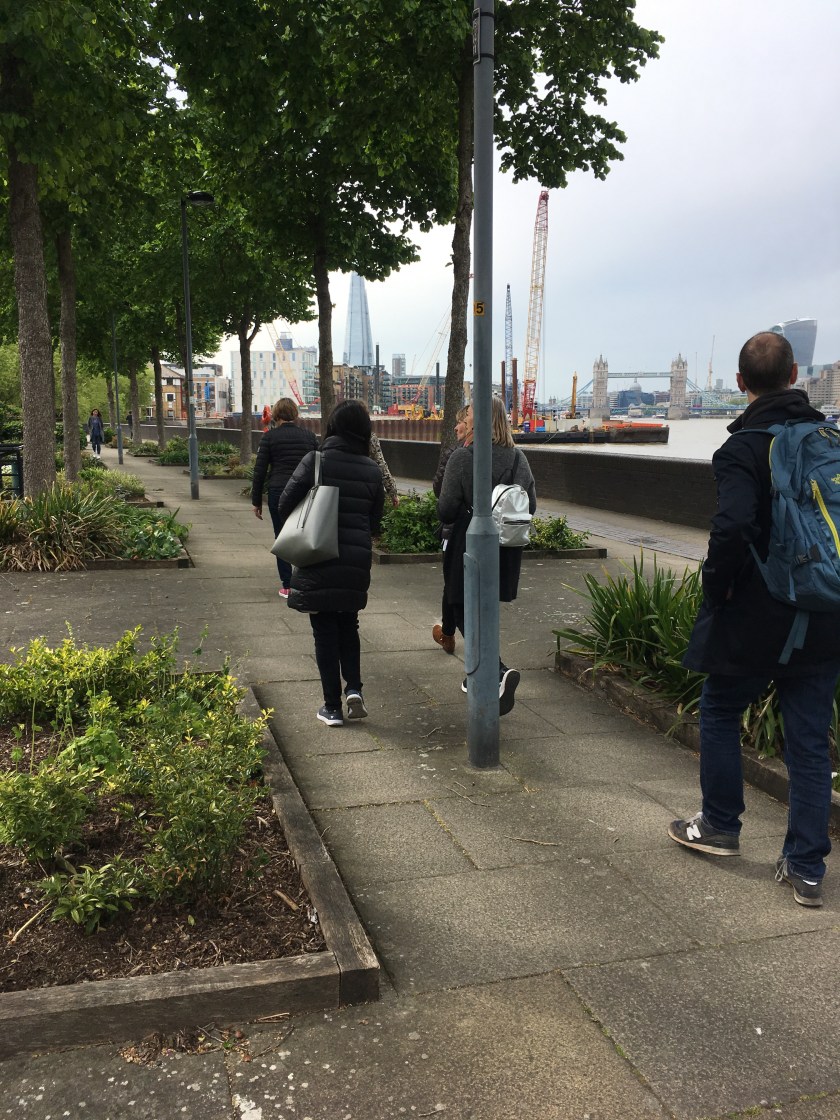 The next walk is on Saturday 13th May at 11am. Click here to book.
The next walk is on Saturday 13th May at 11am. Click here to book.
New Walks for 2017
After a couple of months of hibernation and planning I’m shall be starting to offer a regular programme of walks again from March. I’m excited to announce new walks for 2017 about two women I admire very much.
Ada Salter: Beautifying Bermondsey
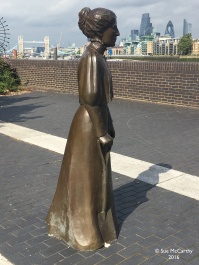
This year Capital Walks ventures south of the River to Bermondsey celebrating the life and achievements of Ada Salter; socialist, pacifist, environmentalist, youth-worker and Quaker. Ada was the first female Mayor in London and the first Labour woman mayor in the British Isles. Ada loved singing and plants; with her husband, local doctor and MP Dr Alfred Salter, she made a significant impact on health, housing, employment and labour relations. The Garden Suburb she created and the tree planting she championed can still be seen today. Oonagh Gay, of Crouch End Walks, and I have put a route together that explores her achievements and the ethical socialism that underpinned them.
Dorothy L Sayers Bloomsbury
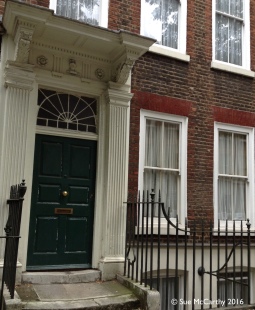
Back in Bloomsbury, I have been indulging long-held enthusiasm for the writing of Dorothy L Sayers and developing a walk around some of DLS’s haunts along with those of her alter ego Harriet Vane and other familiar characters from the novels. See where Peter Wimsey broke his collarbone, where Harriet lived, where her fictional lover Philip Boyes imbibed Strong Poison and find out more about the woman who brought them all to life.
An evening walk at 18:30 on 25th April and for DL Sayers birthday weekend 14:00 on 11th June

